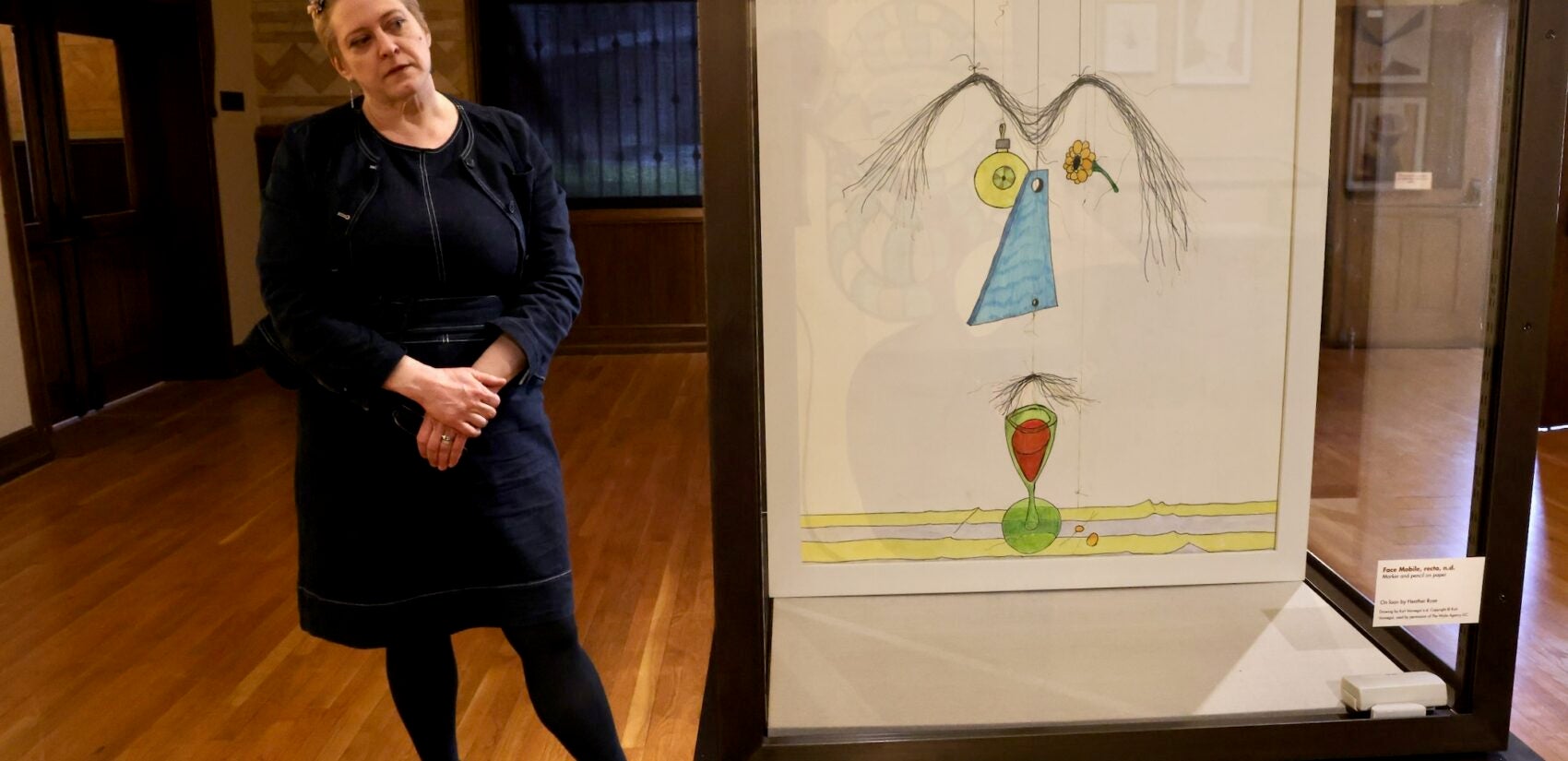The novelist who died in 2007 wrote novels for more than 50 years, while also drawing on the side. Drexel opened an exhibition of two dozen.
From Philly and the Pa. suburbs to South Jersey and Delaware, what would you like WHYY News to cover? Let us know!
Novelist Kurt Vonnegut Jr., whose best selling works like “Slaughterhouse Five” and “Breakfast of Champions” approached tragic and weighty subjects with whimsical absurdity, was lesser known as a visual artist.
Collector Heather Rose is trying to change that. She has collected more than two dozen of Vonnegut’s works and arranged with her alma mater Drexel University to put them on view.
“I think he’s a good artist. I think he couldn’t stop being a good artist,” said Rose, an intellectual property lawyer. “He was playing with so many different styles and he was quite good at them: Calder, Miro, Dadaism, Cubism.”
-
WHYY thanks our sponsors — become a WHYY sponsor
“Kurt Vonnegut Jr. As A Visual Artist,” at the gallery of Drexel’s Paul Peck Center, features surreal line drawings and abstract portraiture made with colored markers on paper.


The exhibition is produced in partnership with the Free Library of Philadelphia, which is hosting workshops promoting writer and artist support with the Philadelphia Volunteer Lawyers for the Arts.
Vonnegut, who died in 2007 at age 84, wrote about his art practice as a respite from the laborious stress of writing.
“My own means of making a living is essentially clerical, and hence tedious and constipating,” Vonnegut wrote in his essay collection “Fates Worse Than Death.” “Intruders, no matter how ill-natured or stupid or dishonest, are as refreshing as the sudden breakthrough of sunbeams on a cloudy day.”
-
WHYY thanks our sponsors — become a WHYY sponsor
Although Vonnegut tended to describe his picture-making as folly, a kind of childish doodling reinforced by his chosen medium of colored ink markers, the works show he was serious, revealing rigorous drafting and sophisticated intentionality. The shapes of figures are determined through geographical mapping. Symbols are carefully placed, sometimes without explanation.
Rose points to a blue horizontal line that runs across the top of a portrait of an elongated woman in black. A small dot disrupts the line.
“I was showing this one to his daughter Nanette, and I said, ‘Maybe that was an accident,’” she said. “She looked and me and was, like: ‘No.’”


Rose said she then noticed small dots appearing in several works. But what they mean, if anything, is up to interpretation, as are the figures themselves, which may or may not represent characters from Vonnegut’s 14 novels.
Very few of the images are titled and none are dated. The first piece Rose bought was “Identical Twins,” a single face that has different features on the left and right side. She believes the figures are the twin brother and sister characters from the 1976 novel “Slapstick.”
The elongated woman in black might be Mona, the love interest in “Cat’s Cradle,” as Rose believes. Or, from a different perspective, she might resemble the original 1915 criminal mastermind Irma Vep from the French silent film serial “Les Vampires.”
“When I brought Nanette Vonnegut around to look at these she said, ‘Oh yeah, my dad would probably agree with you,’” Rose said. “He was friendly about leaving people up to their own interpretations.”


Some symbols in the drawings are identical to the illustrations Vonnegut peppered throughout the text of his 1973 novel “Breakfast of Champions.”
Nanette Vonnegut, herself an artist, published many of her father’s drawings in a 2014 book “Kurt Vonnegut Drawings.” In the preface, she wrote that her father pursued art because it was more fun than his day job: writing.


“Had my father been granted two lives, I have no doubt he would have mastered some aspect of the visual arts,” she wrote. “And he would have cursed it and wished he had been a poet instead.”
“Kurt Vonnegut Jr. As A Visual Artist” will be on view at Drexel’s Paul Peck Gallery until July 19. Rose, who does not keep the collection in her home, said she plans to give it on long-term loan to an institution still to be identified.
-
WHYY thanks our sponsors — become a WHYY sponsor
WHYY is your source for fact-based, in-depth journalism and information. As a nonprofit organization, we rely on financial support from readers like you. Please give today.
